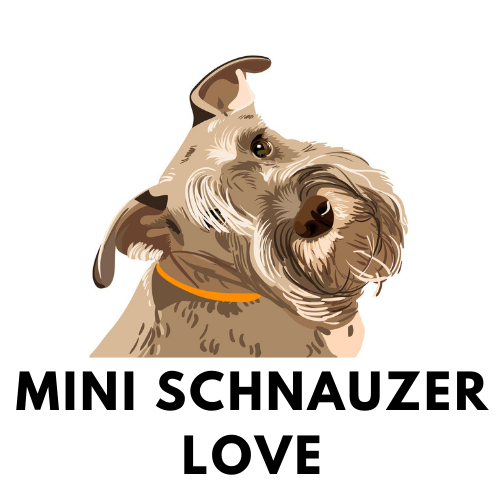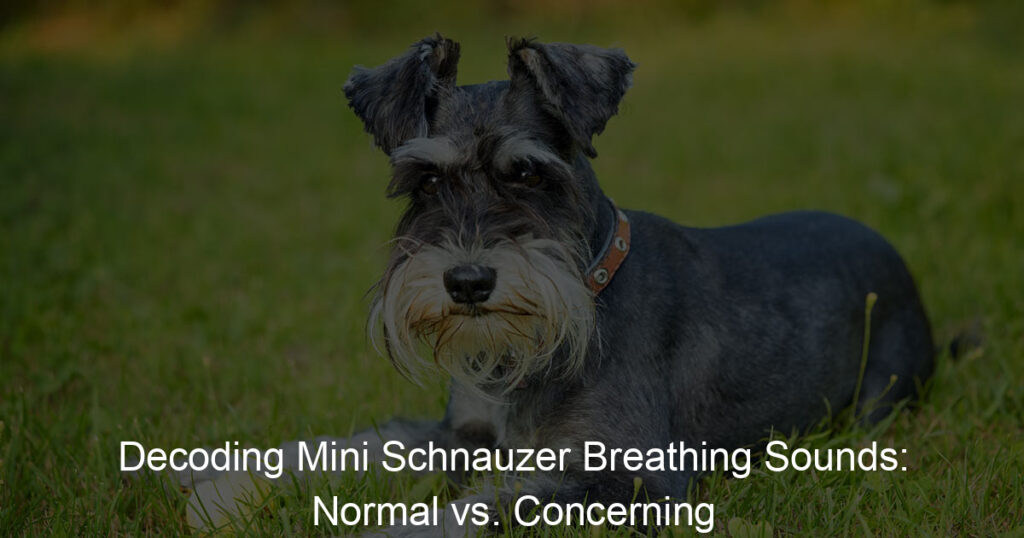
Introduction to Mini Schnauzer Breathing
When it comes to the health of your Mini Schnauzer, understanding and monitoring their breathing is crucial. This guide will help you understand the basics of Mini Schnauzer breathing and why it’s important to keep an eye on their breathing sounds.
- Understanding Mini Schnauzer Breathing
- Importance of Monitoring Schnauzer Breathing Sounds
Mini Schnauzers, like all dogs, breathe in and out to take in oxygen and expel carbon dioxide. However, their small size and unique anatomy can sometimes make their breathing patterns a bit different from other breeds. A healthy Mini Schnauzer’s breathing should be regular and unlabored. When they’re resting, you might notice their chest rising and falling in a steady rhythm. This is normal and a sign of good health.
Monitoring your Mini Schnauzer’s breathing sounds is a key part of ensuring their overall health. Changes in their breathing sounds, such as wheezing, coughing, or labored breathing, can be an early sign of health issues. By keeping a close ear on your Schnauzer’s breathing, you can catch potential problems early and get your furry friend the help they need.
Understanding and monitoring your Mini Schnauzer’s breathing is a simple yet effective way to keep them healthy and happy. Stay tuned to learn more about normal breathing in Mini Schnauzers, when to worry about their breathing, and how to focus on their respiratory health.
Normal Breathing in Mini Schnauzers
Understanding the normal breathing patterns of your Mini Schnauzer is crucial for monitoring their health. Let’s delve into the characteristics of normal breathing in these adorable pets.
Characteristics of Normal Breathing
Normal breathing in Mini Schnauzers is characterized by a certain rate and specific sounds. Let’s explore these in detail.
- Typical Mini Schnauzer Breathing Rate
- Common Schnauzer Breathing Sounds
The average breathing rate for a resting Mini Schnauzer is between 15 and 30 breaths per minute. This rate may increase during playtime or exercise, but it should return to normal when your pet is relaxed. It’s important to note that puppies may have a slightly higher breathing rate than adult dogs.
When your Mini Schnauzer is breathing normally, you should hear quiet, smooth, and regular breaths. Occasional snorts or snuffles can be normal too, especially after sniffing around. However, constant or unusual noises like wheezing, whistling, or raspy sounds could indicate a problem and should be checked by a vet.
Monitoring your Mini Schnauzer’s breathing can help you catch any potential health issues early. Remember, it’s always better to be safe than sorry when it comes to your furry friend’s health.
Factors Influencing Normal Breathing
Just like humans, Mini Schnauzers’ breathing can be influenced by several factors. It’s important to understand these factors to ensure your pet’s health and well-being. Let’s delve into the three main factors that can affect your Mini Schnauzer’s breathing.
- Age
- Activity Levels
- Temperature and Weather
As Mini Schnauzers grow older, their breathing patterns may change. Puppies tend to breathe faster than adult dogs because they are growing and need more oxygen. As they mature, their breathing rate typically slows down. However, if you notice any sudden or drastic changes in your adult Mini Schnauzer’s breathing, it’s best to consult a vet.
Activity levels greatly influence a Mini Schnauzer’s breathing. When your pet is active or excited, it will naturally breathe faster to meet its increased oxygen needs. After a period of rest, its breathing should return to normal. Always ensure your Mini Schnauzer gets adequate rest after high-energy activities.
Temperature and weather conditions can also affect your Mini Schnauzer’s breathing. In hot weather, dogs may pant to cool down, which can make their breathing seem faster or heavier. In cold weather, they may take shorter, quicker breaths. It’s crucial to provide a comfortable living environment for your pet, protecting it from extreme temperatures.
In conclusion, understanding these factors can help you better monitor and manage your Mini Schnauzer’s breathing. Always remember, if you notice any unusual or concerning changes in your pet’s breathing, don’t hesitate to seek professional help.
When to Worry About Schnauzer Breathing
As a Mini Schnauzer owner, it’s important to understand your pet’s normal breathing patterns. This knowledge will help you identify any changes that could indicate a health issue. Let’s discuss some signs that may suggest your Mini Schnauzer is having breathing problems.
Signs of Breathing Problems in Mini Schnauzers
It’s crucial to monitor your Mini Schnauzer’s breathing regularly. Here are some signs that may indicate your pet is having difficulty breathing:
- Changes in breathing rate: If your Mini Schnauzer is breathing faster or slower than usual, it could be a sign of a problem. Normal breathing for dogs is typically between 15 and 30 breaths per minute. If your pet’s breathing rate deviates from this range, it’s time to consult a vet.
- Unusual breathing sounds: Pay attention to any unusual sounds your Mini Schnauzer makes while breathing. Wheezing, snorting, or raspy breathing can indicate a respiratory issue. Remember, it’s always better to be safe than sorry. If you notice any unusual sounds, it’s best to seek professional help.
- Visible distress or discomfort: If your Mini Schnauzer seems uncomfortable, restless, or is struggling to find a comfortable position to breathe, it could be a sign of a breathing problem. Other signs of distress can include excessive panting, coughing, or reluctance to exercise.
Remember, these are just potential signs of a problem. If you notice any of these symptoms in your Mini Schnauzer, it’s important to consult with a veterinarian. They can provide a proper diagnosis and treatment plan for your pet’s specific needs.
Common Mini Schnauzer Breathing Issues
Mini Schnauzers, like all dogs, can experience certain health issues that affect their breathing. Let’s explore three common breathing problems that Mini Schnauzers may encounter.
- Brachycephalic Syndrome
- Tracheal Collapse
- Respiratory Infections
Although this condition is more common in flat-faced breeds, Mini Schnauzers can also suffer from Brachycephalic Syndrome. This syndrome is characterized by a combination of upper airway problems, including a narrow nostril, long soft palate, or a small trachea. These issues can cause difficulty in breathing, snoring, or even collapse in severe cases. It’s important to monitor your Mini Schnauzer for any signs of struggle or discomfort while breathing.
Tracheal collapse is a condition where the trachea, or windpipe, becomes weak and flattens out. This can lead to coughing, difficulty breathing, and a high-pitched, honking cough. This condition is more common in small breed dogs like the Mini Schnauzer. If your dog is coughing excessively or having trouble breathing, it’s essential to seek veterinary care immediately.
Just like humans, dogs can also catch respiratory infections. These infections can cause symptoms like coughing, wheezing, and difficulty breathing. Mini Schnauzers are susceptible to a variety of respiratory infections, including kennel cough and pneumonia. Regular vaccinations and good hygiene practices can help prevent these infections.
In conclusion, while Mini Schnauzers are generally a healthy breed, they can suffer from certain breathing issues. As a responsible pet owner, it’s important to be aware of these conditions and monitor your dog’s breathing regularly. If you notice any changes or signs of distress, don’t hesitate to consult with a veterinarian.
Mini Schnauzer Health: Focusing on Respiratory Health
When it comes to the health of your Mini Schnauzer, respiratory health should be a top priority. This section will provide you with essential tips on how to maintain good respiratory health in your furry friend.
Maintaining Respiratory Health in Mini Schnauzers
Keeping your Mini Schnauzer’s respiratory health in check involves a few key steps. Here are the most important ones:
- Regular vet check-ups: Regular visits to the vet are crucial. Your vet can monitor your Mini Schnauzer’s overall health and detect any potential respiratory issues early. Early detection can lead to more effective treatment and a better prognosis.
- Proper diet and exercise: A balanced diet and regular exercise can help maintain your Mini Schnauzer’s overall health, including respiratory health. Exercise helps to strengthen the respiratory system, while a balanced diet provides the necessary nutrients for optimal health.
- Monitoring for signs of breathing problems: As a Mini Schnauzer owner, you should be aware of the signs of respiratory problems. These can include coughing, wheezing, or difficulty breathing. If you notice any of these signs, it’s important to seek veterinary care immediately.
By following these steps, you can help ensure your Mini Schnauzer maintains good respiratory health. Remember, a healthy Mini Schnauzer is a happy Mini Schnauzer!
Case Study: Overcoming Breathing Problems in Mini Schnauzers
Now, let’s delve into some real-life examples of Mini Schnauzers who have faced and overcome breathing problems. We will focus on two common respiratory issues: tracheal collapse and brachycephalic syndrome.
- Case 1: Treating Tracheal Collapse
- Case 2: Managing Brachycephalic Syndrome
Tracheal collapse is a condition where the trachea, or windpipe, becomes weak and flattens out. This can make it hard for a dog to breathe. Let’s look at the case of Max, a 7-year-old Mini Schnauzer.
Max’s owners noticed he was coughing a lot and seemed to have trouble catching his breath after short walks. After a visit to the vet, Max was diagnosed with tracheal collapse. His treatment plan included medication to reduce inflammation and coughing, as well as a special harness to avoid pressure on his neck. With these changes, Max’s condition improved significantly, and he was able to enjoy his walks again.
Brachycephalic syndrome is a condition seen in dogs with short noses and flat faces. While Mini Schnauzers don’t typically fall into this category, some may still experience related issues. Bella, a 5-year-old Mini Schnauzer, is one such case.
Bella was snorting and snuffling more than usual, and her owners noticed she was struggling to breathe at times. The vet diagnosed Bella with a mild form of brachycephalic syndrome. Bella’s treatment involved managing her weight, using a humidifier at home, and avoiding strenuous exercise during hot weather. With these adjustments, Bella’s breathing became much more comfortable, and she continues to lead a happy, active life.
These cases highlight the importance of early detection and appropriate treatment for breathing problems in Mini Schnauzers. Regular vet check-ups and careful observation of your pet’s behavior can make a significant difference in their respiratory health.
| Condition | Symptoms | Treatment |
|---|---|---|
| Tracheal Collapse | Coughing, difficulty breathing after exercise | Medication, special harness |
| Brachycephalic Syndrome | Snorting, snuffling, difficulty breathing | Weight management, humidifier, avoiding strenuous exercise in hot weather |
Conclusion: Understanding and Monitoring Your Mini Schnauzer’s Breathing
As we wrap up our discussion on Mini Schnauzer’s breathing, it’s essential to remember the importance of understanding and monitoring your pet’s respiratory health. Let’s summarize the key takeaways and share some final thoughts on Mini Schnauzer breathing sounds.
- Key takeaways on Mini Schnauzer respiratory health
- Final thoughts on Mini Schnauzer breathing sounds
Mini Schnauzers, like all dogs, have a unique breathing pattern that can be affected by various factors, including their health status, environment, and physical activity. Normal breathing rates for Mini Schnauzers range from 15 to 30 breaths per minute. However, any significant changes in your pet’s breathing pattern, such as rapid breathing, excessive panting, or difficulty breathing, could indicate a health issue and should be addressed immediately.
Regular vet check-ups are crucial to ensure your Mini Schnauzer’s respiratory health. Additionally, maintaining a healthy diet, regular exercise, and a stress-free environment can significantly contribute to your pet’s overall well-being.
It’s normal for Mini Schnauzers to make certain sounds while breathing, like snorting or snuffling, especially during sleep or after vigorous exercise. However, unusual or persistent noises, such as wheezing, coughing, or labored breathing, could be a sign of respiratory problems.
Always remember, you know your Mini Schnauzer better than anyone else. If you notice any changes in their breathing sounds that concern you, don’t hesitate to seek professional advice. Your vigilance can make a significant difference in your pet’s health and happiness.
In conclusion, understanding and monitoring your Mini Schnauzer’s breathing is a vital part of pet ownership. It not only ensures your furry friend’s health and comfort but also strengthens the bond between you and your pet. So, keep a close eye on your Mini Schnauzer’s breathing and enjoy the wonderful companionship they offer.














